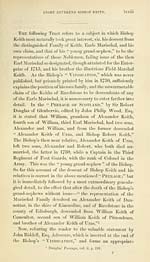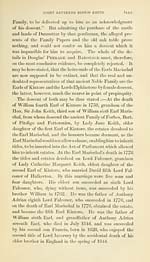Spottiswoode Society > History of the affairs of the Church and State of Scotland from the beginning of the reformation to the year 1568 > Volume 1
(82) Page lxxiv
Download files
Complete book:
Individual page:
Thumbnail gallery: Grid view | List view

lxxiv BIOGRAPHICAL SKETCH OF THE
conclusion to it, and without entering into the question of
family descent, it is only fair to inform the reader who may
take an interest in such matters, that the preceding account
is altogether spurious and unfounded. Keith of Dunnottar
was not descended from William Keith of Camculter, second
son of William Keith of Pittendrum, and brother of Alex-
ander Keith of Uras. The ancestors of the Keiths of Dun-
nottar were feuars or tenants of the Marischal Family, of the
same name undoubtedly, but no connections of those Earls.
Mr Wood prominently refers to " a more particular account
of the family of Keith of Ravelstone inserted in Douglas 1
Baronage ;" but that Work is in many of its details very
inaccurate, and little reliance can bo placed on its state-
ments, which seem to have been inserted in numerous in-
stances, to gratify individual vanity. Alexander Keith, Esq.
of Ravelstone, " one of the Under-Clerks in the Court of
Session, 1 ' whose claims Bishop Keith refuted, is said to have
been born on the 9th of March 1705, and died 12th Septem-
ber 1792, leaving four sons and two daughters, several
other children having died young, by his wife, a daughter
of Sir John Swinton of Swinton in Berwickshire. By that
marriage his family and descendants became relatives of
Sir Walter Scott. It is farther stated that " this Alexander
Keith of Ravelstone purchased in 1766, from George Earl
Marischal, the castle and lands of Dunnottar ; and the
Earl ordered the whole Family Papers, and the black stock
of Dunnottar, an oaken table said to be brought by the
Oatti 1 from Germany, reckoned an ancient heir-loom of the
1 According to the Peerage account of the Marischal Family, which
■professes to be derived from the " most authentic historians," Robert,
leader of a tribe of the Catti, who emigrated from Germany into Scotland,
killed Camus, the commander of the Danes, at Barry in Forfarshire, in a
great battle fought between them and the Scots under Malcolm II. in
A. D. 1010. It is farther recorded that the King dipped his fingers in
the blood of Camus, and " drew three perpendicular strokes on the upper
part of Robert's shield, whence his descendants bear three pallets, gules,
on a chief. Malcolm, in regard of his eminent sendees, created him Heri-
table Great Marischal of Scotland, and bestowed on him several lands,
particularly some in East Lothian, still called Keith, the ancient name
Catti being in process of time transposed to Kethi and Keycht ; and still
move lately, for softness of pronunciation, Keith. " — Dorc.LAs' Peerage,
vol. ii. p. 1^4.
conclusion to it, and without entering into the question of
family descent, it is only fair to inform the reader who may
take an interest in such matters, that the preceding account
is altogether spurious and unfounded. Keith of Dunnottar
was not descended from William Keith of Camculter, second
son of William Keith of Pittendrum, and brother of Alex-
ander Keith of Uras. The ancestors of the Keiths of Dun-
nottar were feuars or tenants of the Marischal Family, of the
same name undoubtedly, but no connections of those Earls.
Mr Wood prominently refers to " a more particular account
of the family of Keith of Ravelstone inserted in Douglas 1
Baronage ;" but that Work is in many of its details very
inaccurate, and little reliance can bo placed on its state-
ments, which seem to have been inserted in numerous in-
stances, to gratify individual vanity. Alexander Keith, Esq.
of Ravelstone, " one of the Under-Clerks in the Court of
Session, 1 ' whose claims Bishop Keith refuted, is said to have
been born on the 9th of March 1705, and died 12th Septem-
ber 1792, leaving four sons and two daughters, several
other children having died young, by his wife, a daughter
of Sir John Swinton of Swinton in Berwickshire. By that
marriage his family and descendants became relatives of
Sir Walter Scott. It is farther stated that " this Alexander
Keith of Ravelstone purchased in 1766, from George Earl
Marischal, the castle and lands of Dunnottar ; and the
Earl ordered the whole Family Papers, and the black stock
of Dunnottar, an oaken table said to be brought by the
Oatti 1 from Germany, reckoned an ancient heir-loom of the
1 According to the Peerage account of the Marischal Family, which
■professes to be derived from the " most authentic historians," Robert,
leader of a tribe of the Catti, who emigrated from Germany into Scotland,
killed Camus, the commander of the Danes, at Barry in Forfarshire, in a
great battle fought between them and the Scots under Malcolm II. in
A. D. 1010. It is farther recorded that the King dipped his fingers in
the blood of Camus, and " drew three perpendicular strokes on the upper
part of Robert's shield, whence his descendants bear three pallets, gules,
on a chief. Malcolm, in regard of his eminent sendees, created him Heri-
table Great Marischal of Scotland, and bestowed on him several lands,
particularly some in East Lothian, still called Keith, the ancient name
Catti being in process of time transposed to Kethi and Keycht ; and still
move lately, for softness of pronunciation, Keith. " — Dorc.LAs' Peerage,
vol. ii. p. 1^4.
Set display mode to: Large image | Transcription
Images and transcriptions on this page, including medium image downloads, may be used under the Creative Commons Attribution 4.0 International Licence unless otherwise stated. ![]()
| Permanent URL | https://digital.nls.uk/79597772 |
|---|
| Description | Volume I. |
|---|---|
| Attribution and copyright: |
|

